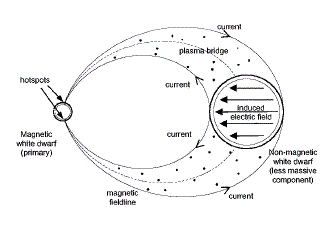A new form of stellar energy?
A new form of stellar energy?
The X-ray source RX J1914+24 was discovered using ROSAT and was found
to vary on only one period - 569 sec. Further work by astronomers at
MSSL suggested that this period represented both the spin period of
the accreting white dwarf and also the binary orbital period. This
short period implied that the mass donating could not be a main
sequence star as found in other accreting binary systems but had to be
a white dwarf. RX J1914+24 was therefore proposed as a double
degenerate polar: `double-degenerate' because both binary components
were degenerate stars (white dwarfs) and `polar' because polars are
accreting binary systems in which the accreting white dwarf has a
magnetic field strong enough (10-200MG) to synchronise its spin period
with the binary orbital period (see
Cropper et al 1998) and
Ramsay et al 2000).
However, further observations led by astronomers at MSSL
found that two of the distingushing characteristics of polars -
polarised optical light and optical emission lines - were absent
Ramsay et al 2002). This paper proposes several other scenarios
for RX J1914+24. These include a double degenerate Algol system (also
proposed independently by Marsh & Steeghs 2002), a neutron star-white
dwarf pair and a unipolar-inductor model (or electric star model). The
latter model would represent a third form of stellar energy after
nuclear and accretion power. It is described more fully in
Wu et al 2002) .
This proposal may seem rather far-fetched. However, we do
know that a similar effect has been observed on Jupiter where its
satellite's rotate round the magnetic field of Jupiter causing
electrical currents to be driven. These are deposited in the Jovian
atmosphere causing bright streaks which were imaged using the Hubble
Space Telescope:

This image shows both the aurora on Jupiter (caused by the
same effect as the Northern lights we observe on Earth) and also the
footpoints of three of Jupiters satellites. Each footprint is
represented by a bright dot. Io's footprint is at far left; Ganymede's
is just below and to the right of center; and Europa's is to the right
of Ganymede's signature.
In the case of RX J1914+24, the currents which are generated
are much greater than that in Jupiter since the secondary white dwarf
is rotating around the primary white dwarf on a much shorter timescale
and its mass is much greater than that of Jupiter's satellites. The
diagram below shows how the energy is liberated on the magnetic white
dwarf:
 This model can explain all the observed characteristics of RX
J1914+24. More detail of this model can be found in
Wu et al 2002) .
This model can explain all the observed characteristics of RX
J1914+24. More detail of this model can be found in
Wu et al 2002) .


